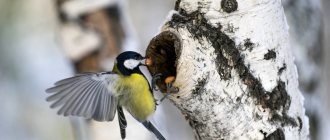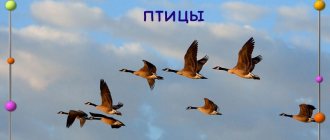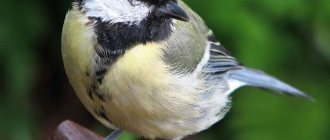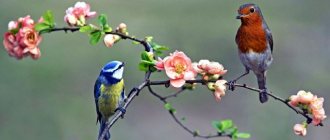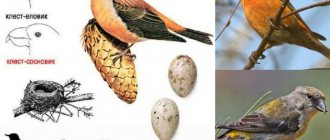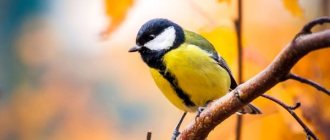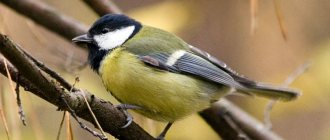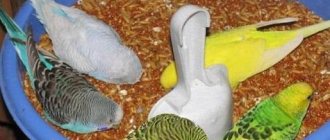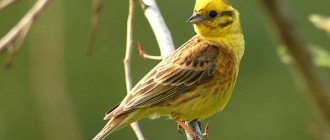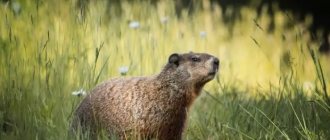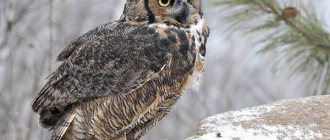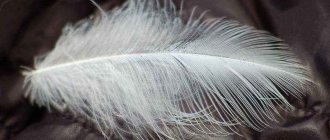It is very difficult for birds that come to our region to spend the winter to find at least some food for themselves during the coldest time of the year. All insects are in hibernation.
Plant food in the form of fruits and berries, even if it remains somewhere, is certainly covered with snow. And if their warm feathers save birds from the cold, then there is little that can save them from hunger.
Here people come to the aid of birds. They set up feeders and feeding areas to make it easier for the birds to survive the harsh season.
But it is worth remembering that, while striving for the best, you can inadvertently harm them, and it is important to know what you can feed tits in winter.
Why do tits love lard?
Small birds have very fast metabolisms and require a lot of energy just to survive. This is especially true in the cold season, when additional energy costs for protection from the cold are added. Three reasons why tits eat lard:
- they are predators, lard is their natural food;
- fat contains a lot of energy, which is so necessary for tits;
- lard is available - every second fan of feeding birds in winter hangs lard for tits.
As a child, I read a book that described an ancient method of tanning hides. After preliminary mechanical cleaning, the animal skins were hung in the barn. At the same time, access was left for tits. The birds flew up freely and pecked the remaining meat and fat from the skins, as a result of which they became softer. Perhaps the tradition of feeding tits with lard has been going on for a long time.
What are the advantages of feeding tits with fat:
- high nutritional value;
- lard is cheap, in meat departments they give pork skins for practically nothing;
- it is easy to buy, even in comparison with seeds;
- you can use any fat (pork, beef, lamb);
- the lard hangs on the branch for a long time, which allows you to feed the birds at your dachas, where you appear once a week;
- tits stay on the piece for a long time, which makes it possible to observe them well;
- the lard also attracts other birds.
Disadvantages of feeding birds lard:
- it can only be hung in cold weather - lard spoils in the heat;
- You cannot feed tits with salted lard;
- pieces of lard on the branches do not look aesthetically pleasing;
- Fat can be stolen by cats and large birds (crows, magpies, rooks), so it is better to tie it to a branch. I have a video about the rook’s attempts to steal lard.
General feeding rules
First of all, it is important to remember: we are only talking about feeding, so there should be enough food for your feathered charges to eat it at one time.
An enhanced diet is justified only in severe frosts. This may seem cruel, but if you give titmice too much food, they will quickly get used to the “easy” life and lose the ability to look for food on their own.
To set up a bird canteen, it is advisable to find a secluded place located high enough above the ground so that rodents and pets cannot reach it. Schedule feeding at a certain time, and the smart titmouse will quickly learn the daily routine.
Months when tits (and other birds wintering in the city) need feeding:
- from early November to mid-April.
It is important to take into account that the titmouse needs to adhere to a certain “diet”. Prohibited:
- Any bread baked with yeast that causes fermentation in the stomach
- Fried foods, everything salty, spicy, sweet.
- Raw cereals, dairy products, potatoes, cabbage, peas.
The best treats for the yellow-breasted tiny bird would be:
- Any raw seeds: pumpkin, flax, sunflower;
- Dried berries of rowan, hawthorn, cranberry, lingonberry;
- Crushed almonds, peanuts, walnuts (also raw);
- Finely crushed hard-boiled egg, apple slices, unleavened bread.
- And, of course, lard.
Seeds, peanuts and nuts are the best choice for tits
These three types of food are taken away by tits first. The seeds and nuts are easy to grab and fly away to peck in a cozy place. Tits often store food; they especially like to hide cosmos seeds. A couple of these little blackies visit my feeder every day in the winter.
But great tits rarely store food, but prefer to eat it right away (on the spot or by flying to a neighboring branch). Small Muscovites, apparently, cannot compete so quickly and decide to visit the feeder more often in order to hide the seeds in reserve. In addition to Muscovites, chickadees and tufted tits engage in stocking activities. Research shows that tits can stock up throughout the year.
Read about when to feed the birds in this article - When to start feeding the birds: Autumn is the time to fill the feeders!
Sunflower seeds are an ideal option for feeding birds all year round:
- they do not deteriorate in the sun and under the influence of oxygen. Only moisture can cause them to deteriorate, so place the seeds in a covered feeder;
- rich in nutritious fat and easily digestible by birds;
- sparrows prefer smaller grains, so tits have fewer competitors (but it is necessary to protect food from pigeons - they will quickly destroy all supplies!);
- Other beautiful birds also feed on the seeds - greenfinches, crossbills, goldfinches;
- you can put a lot of sunflower seeds into the mesh feeders and provide birds for a long period;
- long shelf life - you can buy a large bag once and it will last for the whole winter.
A great tit pecks at a sunflower seed.
Tits like nuts and peanuts even more, but the cost of these foods makes feeding tits very expensive. Nuts should be placed exclusively in mesh feeders so that birds cannot drag them up the tree - most often the titmouse will not completely peck the nut, but will throw most of it into the snow. And from the mesh feeder, the birds are forced to peck out pieces little by little.
In addition to the cost, shelled nuts have another disadvantage - the fat quickly oxidizes in air and goes rancid. It would be doubly disappointing if such expensive food spoils and the tits are never able to enjoy it.
What to feed?
Not only great tits, but other species of the tit family: chickadees, tits, blue tits are clever hunters, accustomed to high-calorie protein foods. Only when there is very little prey do they begin to actively switch to other food. It is in the cold that tits begin to massively eat the plant foods that we usually treat them to. But remember - these birds are predominantly insectivores, so various animal products (lard, butter, eggs) are as natural and healthy for them as plant foods. What should you put in a feeder or hang on a tree for these tireless and lively birds?
Unshelled sunflower seeds
Universal and one of the most favorite foods for tits, and not only for them. The seeds are readily pecked by many small birds - greenfinches, nuthatches, and other birds.
Important! The seeds should be raw (not fried) and without salt.
The seeds are good because they contain a lot of fat (52.9 g per 100 g) and a balanced amount of protein and carbohydrates (protein - 20.7 g per 100 g). They are very high in calories and can help small birds quickly replenish their energy supply, which is so necessary to maintain the desired body temperature in cold weather. Among the disadvantages of seeds, it should be noted that cheap seeds on sale can be rancid or moldy. Another disadvantage is that the seeds are quickly pecked by pigeons, which, of course, also have a hard time in winter, but still not as much as small birds. Therefore, if you want to feed small birds, you will have to think about how to protect this food from larger ones (for example, use hanging feeders with small holes).
For seeds, you can buy or make a feeder with small holes
Pros and cons of seeds
- Pros:
- easy to buy
- relatively inexpensive
- high in calories and tits like it
- Minuses:
- spoil during storage, so when buying cheap seeds you need to be careful
- quickly eaten by large birds in regular feeders
Tits eat peeled sunflower seeds much worse than unpeeled ones. It's better not to offer them to them.
Unsalted lard
Of the animal feeds for tits in winter, lard is the No. 1 food. The lard must be unsalted and unsmoked, without pepper or any spices or additives. Extremely high in calories, it is consumed slowly and tits like it. In fact, this is a con charge that you only need to peck a few times and the bird is already full. Pork lard is usually used - since it is the most common, but both lamb and beef fat are suitable for tits.
Tits are agile acrobats that easily eat lard on a string.
Lard can be hung on strong ropes (for example, lavsan thread) - this is convenient in cases with lump lard. Nimble tits sit on such pieces and can pinch off as much as they need with their beaks. You can buy lard trimmings on skins - in these cases there is not much lard, but a strong skin is a convenient base for wrapping such pieces to tree branches. In addition to tits, woodpeckers willingly fly to such fixed fat. Among other birds, jackdaws and crows also love lard.
Sparrows are usually indifferent to lard, but in cold weather they can begin to feed on it.
If you buy lard for the birds for the whole winter, then you need to keep the supply in the refrigerator, since when stored outside it can become airy or even spoil during thaws. For the same reason, you should not hang or secure very large pieces for birds - it is better to add them later as needed.
Pros and cons of lard
- Pros:
- low consumption
- the most satisfying food
- ideal for those who cannot regularly add food to the feeder (for example, they rarely go to the country in winter)
- convenient to stock up for the whole winter
- Minuses:
- fixed, can quickly be eaten by jackdaws, crows and cats (if they get there)
- may go rancid if there are frequent thaws or if hung at above-zero temperatures.
- It is more likely a food for emergency help for birds in cold weather than for constant consumption, since it contains almost no proteins and does not contain carbohydrates at all, that is, it is not a complete food for long-term feeding
Shelled nuts
High-calorie foods suitable for tits include nuts. And here it’s worth mentioning right away about their different types. The favorite foods of these birds are shelled walnuts. They are soft, extremely nutritious and they love them. Our observations show that walnuts are simply “swept away” by tits. True, the price makes them a bird “delicacy”, and not a constant mass feed. However, if you suddenly happen to have a lot of shelled walnuts, then you can safely share them with the titmouse, they will only benefit them. Well, or if you want to diversify the bird “menu”, you can also pour a handful of them into your feeder. The downside of these nuts, besides the high price, is that they go bitter very quickly. A more budget-friendly and shelf-stable option is raw, shelled peanuts. It is also called red peanut.
Important! All nuts should be unroasted and unsalted.
There are possible options here - some tits love peanuts, some not so much. But in general, they eat this food very well. It is better to place peanuts in special mesh feeders so that they are not scattered by birds and do not go to waste. You can also use other peeled raw nuts - cashews, hazelnuts. The latter, however, is a last resort - it is too big and hard for tits. It is quite problematic for them to peck at it, so if possible, use softer nuts.
A mesh feeder is the best option for nuts
Pros and cons of nuts
- Pros:
- high-calorie
- tits like soft species
- Minuses:
- more expensive than other foods (especially some types of nuts)
- when simply poured into a feeder, they can mostly go to waste, since tits drop them when trying to carry them away and peck them - mesh feeders are needed for nuts
Unpeeled pumpkin, melon, watermelon seeds
These seeds can also be offered to tits if you have the opportunity. Some tits love pumpkin seeds and willingly eat them along with sunflower seeds, while others may treat them without much enthusiasm - here the birds show their own individual preferences. However, almost all tits love melon seeds (although they are difficult to get - unless you dry them yourself).
By the way, it is better to choose smooth and thin-skinned pumpkin seeds for feeding tits - they are easier to peck. The thicker their shell, the more difficult it will be for birds to get to the core they need.
Small melon seeds are a great food
Tits do not favor peeled pumpkin seeds - this food can simply sit idle or be wasted.
Pros and cons of pumpkin, melon and watermelon seeds
- Pros:
- quite high in calories
- if you prepare it yourself, it’s free
- Minuses:
- not everyone and not everywhere has it at hand
Millet
Rounding out the top five along with seeds, lard and nuts is millet. This is one of the traditional foods that many are used to feeding small birds. True, lately there have been many voices against millet on the Internet - they say that it is harmful to tits and almost fatally dangerous. I had to conduct a whole little investigation to find out whether there is any scientific basis for such statements or if it’s just another online myth. What's the end result? Everything turned out to be just rumors. There is not a single ornithological study that suggests that millet is harmful to tits. No confirmation, no facts. On the contrary, observations by bird lovers (and our experience too) confirm that tits peck millet without any terrible consequences and can survive the winter on this food.
Of course, the millet should not be moldy, old or bitter. This, of course, will not benefit anyone.
There is really one nuance with millet - if there are seeds in the feeder, then tits will almost always prefer them. Millet for them is, rather, a reserve food when there is nothing more satisfying. But sparrows, on the contrary, love this particular yellow cereal. So don’t be surprised if, when you decide to feed your tits millet, you see that a whole flock of sparrows are happily pecking at it.
For millet, you can use feeders designed like a dispenser.
Pros and cons of millet
- Pros:
- just buy
- relatively inexpensive
- Minuses:
- not particularly nutritious
- attracts tits only in the absence of seeds
Other foods for tits are used less frequently, but they can also diversify their diet.
Finely chopped apples
Fresh apples for tits should be cut into small pieces. This will make it easier for them to deal with them. Food is not the favorite food of these birds. Suitable for mild frosts. Make sure that the pieces do not spoil or become moldy in the feeder.
Boiled egg
Eggs for tits are hard-boiled, and then either finely chopped and poured into a feeder, or, having cleared only the top, they are completely fixed on trees by threading an insulated wire through the egg.
Butter
A good addition to basic feed, especially in severe frosts. It must be unsalted and natural. You can lay it in a block, or you can hang a piece in a net (for example, from under potatoes or other vegetables). Tits love butter, so this food will definitely be eaten.
You can melt the butter and add seeds to it, and then cool it and hang it in this form.
Pumpkin pulp
The pumpkin pulp, just like apples, is cut into small pieces, or, if the pumpkin is loose and there are not very severe frosts, then the birds can peck at large pieces with seeds, choosing what they like best.
Various cereals
Tits usually eat cereals, unlike various seeds, without enthusiasm. They can peck millet, corn grits, oatmeal, even buckwheat, but other things being equal, they will prefer other food. Specialists in eating cereals are sparrows, and they readily consume cereals.
What kind of cereal can you give?
Tits can be given any cereal, both raw and boiled. There is a myth that tits should not be fed millet because they die from it. Moreover, some say that millet is affected by mold, others claim some kind of oxide film on the cereal, and still others report low nutritional value, as a result of which the birds die with full bellies. But there is no evidence for these words - only rumors on the Internet.
Therefore, you can pour millet, buckwheat, rice, crushed corn and other cereals into the feeder. But don’t expect the tits to pounce on such a treat. My experiments in feeding birds have shown that tits do not really like grain feed.
But there are other types of birds - sparrows will definitely be grateful for such feeding. Therefore, pour cereals into the feeder - there is an eater for every food!
What should you not feed titmouses?
Not only tits, but also other small birds should not be given
:
- Salty
- Roast
- Smoked
- moldy
Roasted seeds, all salted nuts, salted lard, sausage, snacks, canned food are prohibited
.
You should not give black bread
.
White bread is not the best food, but in the form of dried crumbs, you can use it in case of emergency, the main thing is that there is no mold, this is only to be thrown away. Pieces of bread should not be placed in feeders.
Important! Keep the feeders clean so that the food does not stagnate and spoil. Mold is dangerous for birds.
Food in nature in winter and summer
The diet of tits in the cold and warm seasons is very different. This is due not only to the availability of insects in summer, but also to the need to feed chicks that need animal food.
Tit chicks require spiders and insects
Although tits are considered to be useful birds for the garden, in the first days after hatching their chicks receive only spiders. This fact should make arachnophobes happy, but for a gardener the spider is a valuable ally in destroying many harmful insects.
Following the spiders, the tits begin to drag caterpillars and butterflies into the hollow. And the closer the moment of departure comes, the more beetles and bedbugs become in the diet.
Tits bring 20-30 insects into the hollow per hour. Birds work especially intensively in the morning and evening hours, when a tit can appear near the hollow over 30-40 times per hour. Therefore, over the summer, the tit destroys a huge number of garden pests, which is why it is so important to feed these birds.
But even adult birds switch to animal food in the summer. There are a huge number of insects during this period. But even in winter, tits are not averse to eating arthropods. Many beekeepers know how destructive these loud birds can be. Tits can open cracks in hives and feast on bees. You can watch this video of mine about the wrecking of tits:
Dear butchers
The sonorous chirping and bright colors of tits attract our attention. Therefore, they are most often fed at feeders. But behind the cute appearance hides a ferocious predator.
Observations of cavity nesters (birds settling in hollows) revealed an interesting fact: tits can kill up to 10% of pied flycatchers. Most often, the pecked bodies of flycatchers are found in the hollows of tits or near them. Some flycatchers have their brains pecked out, while others have their meat. But most often the dead birds are practically untouched.
As we later found out, tits do not kill them for food. The thing is that by the time the flycatchers arrive, most of the nests are occupied and they are trying to drive the tits out. But the flycatchers do not know who they are messing with - the tits easily deal with the pieds.
But in winter, tits can attack other birds for food. Most often, their victims are tap dancers, which are significantly weaker than tits.
Plant food
Although tits are predators, even in nature they can feed on plant foods. At the end of autumn, sea buckthorn bushes are teeming with tits. Blue tits especially love yellow berries, but great tits do not refuse this treat.
Blue tit feasts on sea buckthorn berries
And in winter, when insects are almost impossible to find, tits become omnivores. Moreover, the main source of plant food for them becomes human housing - birds from the surrounding forests go to towns and cities where it is easier to find food.
Bird feeders
Feathered creatures are warm-blooded, requiring good nutrition to maintain body temperature (+40 C). If things go poorly with nutrition, the bird’s body will begin to cool down. The instinct of self-preservation and hunger drive birds in search of food.
Compact feeders for tits and sparrows can often be found in courtyards of residential areas and parks. Concerned citizens organize similar structures on their balconies.
Bullfinches, sparrows, titmice, goldfinches, and jays flock to the feeder to eat. Often in large feeders you can meet uninvited and impudent guests - crows, jackdaws.
“Canteens” for birds can be made with your own hands or purchased at a pet store. The simplest design is a plank with a roof that protects from natural precipitation, suspended from the corners of a rectangle. There are also creative ideas for creating places for birds to feed from scrap materials. For example, from a milk carton, plastic container, tin cans.
Strange tastes of tits
In addition to the foods we are accustomed to, these birds can consume a wide variety of foods. Tits have long been our neighbors, so there is a lot of evidence about the feeding of birds.
Long live scented soap!
The Russian Ornithological Journal describes a case of tits consuming laundry soap. Vitaly Prokhorov (an employee of a biological station in the Kaluga region) noticed that in the street cupboard there was a piece of laundry soap pecked by birds.
Pecked pieces of laundry soap. Photo by V.G. Prokhorov
The fact that tits eat soap has been described by other observers. Most often, when pecked laundry soap is found, mice and other rodents are suspected. But upon closer examination, it is easy to distinguish pecking from scraping with incisors. And during subsequent observations, ornithologists recorded the fact that tits were eating soap.
But this eating behavior is not surprising. Laundry soap contains a large amount of fat and fatty acids, which are rich in energy, which is so necessary for birds during the winter cold.
Bright scavengers
In winter there is no time for fat - there is no time to be picky, either eat what you have, or freeze and die. Tits constantly flash near garbage dumps, where they find various food. They also do not refuse the flesh of dead animals.
In winter, I watched tits peck at a bone, eating the remains of meat and bone marrow. As already written above, tits are excellent at eating their own kind. This is how a case of tits feeding on the corpse of a pigeon is described. Caesar fell victim to frost, but his meat helped the titmice feed for some time. It is noteworthy that first the tit pecked out the eyes of the pigeon.
Beekeeper's trouble
Insects are the favorite natural food for tits and, fortunately for them, people began to breed very appetizing bees. In winter, bees become very easy prey - the cold deprives them of the ability to defend themselves. Therefore, if the hive is not protected enough and the tit can gain access to it, then good luck!
Tits also feed on bees in the spring, when striped workers are just emerging from the hives towards the warm sun. But here the bees can stand up for themselves and sting the impudent birds.
In addition to the great tit, bee-eating species include bee-eaters and shrikes. These migratory birds appear here in the summer. But together with tits, woodpeckers can destroy hives in winter - these pests break through the walls of the bee’s home with their beaks and catch insects. For beekeepers, such a neighborhood does not bring joy.
Dangerous products
In severe frosts, birds can die from frostbite or starvation. To help them somehow, you can hang out feeders with food. Although tits are distinguished by their omnivorous nature, they cannot eat everything. More precisely, some products can be dangerous to their lives.
Tits do not know what they can and cannot do. Therefore, keep an eye on the contents of the feeder.
This category includes:
- crackers;
- chips;
- salted nuts;
- seeds;
- salted lard.
This restriction applies not only to tits, but to all birds. Their excretory system cannot cope with the accumulated salt. As a result, the bird is poisoned and dies.
The next taboo for birds is fried food. All kinds of fried seeds or nuts can cause liver disease.
Fresh or brown bread, buns, and cookies are dangerous, as they can lead to fermentation in the intestines or volvulus. You should not feed tits with spoiled cereals. All citrus fruits are dangerous.
Literature used in the article:
- Aggressive behavior of the great tit Parus major when defending the nest. V.A.Koshcheev // Russian Ornithological Journal 2022, Volume 28, Express Issue 1822
- Once again about the eating of soap by the great tit Parus major. V.G.Prokhorov//Russian Ornithological Journal 2022, Volume 26
- Food storage in tits Parus spp. and the nuthatch Sitta europaea. A.V.Bardin // Russian Ornithological Journal 2022, Volume 27, Express Issue 1585
- Great tit Parus major feeding on the carcass of a rock pigeon Columba livia. N.N. Berezovikov, A.N. Filimonov // Russian Ornithological Journal 2022, Volume 27, Express Issue 1574
- On the feeding of the great tit Parus major by honey bees Apis mellifera. V.P.Ivanchev // Russian Ornithological Journal 2016, Volume 25, Express issue 1277
- About the consumption of unusual food by great tits Parus major - soap and corn grains. Knysh N.P. // Rus. ornithol. magazine 23 (970): 2014.
- Relationship between the great tit and the urban landscape in winter. Kovalev V.A. Prisada I.A. // Magazine Berkut No. 5, 1996.
- Seasonal dynamics of the food supply and diet of great tit (Parus major) chicks. T.A. Ilyina // Materials of the I All-Russian Scientific Conference “Evolutionary and Ecological Aspects of the Study of Living Matter”. Cherepovets, February 8–9, 2022
Proper feeding
Having analyzed in detail what foods should not be given to tits, another question arises: what to feed tits in the feeder in winter?
The best option is raw pumpkin and sunflower seeds. Buckwheat, rice cereals, oatmeal, watermelon, melon, and zucchini seeds are also suitable.
In addition to seeds, tits can be fed unsalted lard, butter, dried bread crumbs, walnuts or even small pieces of meat.
If you are caring for a tit at home, you can feed it with small portions of cottage cheese, a hard-boiled egg, grated on a coarse grater, and small slices of apple.
You can hang thin branches of fruit trees near the feeder. As a calcium supplement, finely crushed chicken egg shells are poured into the feeder.
Tits should be fed no more than twice a day, in small portions. After all, birds may forget how to look for food for themselves. Therefore, do not overdo it, as a large amount of food in the feeder can harm the birds.
Diet
The tit mainly eats insects in summer. Most of them are unconditional pests of trees - wild and fruit trees. With their cone-shaped beak, slightly flattened on the sides, tits can penetrate various cracks in the bark of trees and shrubs, extracting insect larvae, pupae, and eggs from there. Adults are also eaten. So the question of what titmice eat in the summer can be answered as follows: various insects. This is the great benefit of birds for gardeners: they help destroy pests. And this little bird eats quite a lot: as much as it weighs.
Also, tits sometimes use their beaks to pull out seeds from the cones of coniferous trees and can peck at various fruits.
What does a tit chick look like? Tit chick: what does it look like and how to feed it?
Tits are one of the most common birds in the vastness of our country. They are easy to find not only in forests and fields, but also in any city. Pay attention to the bird the size of a sparrow with a lemon-yellow breast, snow-white cheeks and dark blue wings - this is the same tit. These birds are sedentary; in the fall they rarely fly away, preferring to winter near human habitation.
If you want to feed the tits, hang a piece of lard in a feeder outside the window and sprinkle some bread crumbs - the tits will be right there. But in general, these birds are insectivores, and in nature their diet consists of all kinds of insects.
But what to do if a tit chick falls into your hands? These birds breed twice a year. The first clutch appears in April, and the second at the end of June. The cubs grow quickly, and most often in spring and summer, under the trees here and there, a tit chick - a fledgling - can easily be found. That is, the one that fell out of the nest, but has not yet learned to fly. How to distinguish it? The tit chick (you've probably seen a photo of such a creature of nature) is generally similar to its adult counterparts - the same yellow breast with a dark stripe in the middle will easily help distinguish it from other birds. Except that the color of the wings of young tits is not as bright as that of adults, and the plumage is softer, since it has not yet had time to change from baby fluff to real feathers. What should we do with it?
Remember that if you are ready to take responsibility for the chick, then this is for life. If you, having played enough of a rescuer, fed the chick and kept it in a cage for at least a couple of days, decide to release it into the wild, with a high degree of probability it can be said that it will die. At the same time, the tit chick is completely unpretentious in its maintenance. It can be kept in a cage, but do not expect the bird to become tame - tits are very poorly socialized, remaining quite wild until the end of their lives.
By the way, these birds are often valued among canary breeders. The latter birds adopt the chirping style of tits, and songbirds with this skill are especially respected. Therefore, sometimes they are placed in cages with canaries as a “singing teacher.”
How to feed a tit chick? It is best, of course, that the bird’s diet consists of the food that it would eat in the wild. The best option is insects. But if this is not possible, then tits, like other representatives of songbirds (and ornithologists classify them as this species), can be supplemented with grated boiled eggs, parsley, lettuce, pre-chopped, and non-acidic cottage cheese. The most convenient way to do this is with tweezers. It is important to ensure that the tit chick opens its beak independently when feeding. Chicks can and should only be fed with boiled drinking water. Caring for them is generally similar to caring for canaries, and therefore, as soon as you are sure that you have established the nutrition of your new charge, consider that half the battle is already done. All you have to do is feed, water, and remove waste from the cage on time, and your bird will feel just great and delight you with its cheerful chirping.
Appearance
This bird can be recognized by its conspicuous white cheeks. The head and neck (tie) are painted black. The belly is yellow and the upperparts are bluish-black or olive, with slight variations among many subspecies. On the back of the head you can see a white spot with a yellowish tint. The wings and tail are blue. The bird itself resembles in appearance a brightly colored sparrow (it is not for nothing that it is classified among the large order of passerines). The blue-yellow and black color is very noticeable in the forest, especially in winter.
The tit has strong legs and tenacious claws, allowing it to hang upside down in search of food in the trees. This is a very active and fidgety bird. Body weight – up to 20 grams, length – 15 cm, wingspan – up to 25 cm. The name “tit” is supposed to come from the fact that some of the bird’s feathers are blue.
Insectivorous birds in my garden
After 10 years, my garden, from a primitive lifeless system where rare weeds grew on dry sand, turned into a complex living community consisting of cultivated and wild plants and animals that settled in it, that is, the garden became an ecological system.
And this happened when in the spring a nightingale sang in the garden and an oriole began to cry, when insectivorous birds began to build nests in my garden. The oriole is very shy, but sings and cries wonderfully.
Harmful insects in the garden can be destroyed with pesticides, but in such a garden the warbler will not build a nest and hatch chicks. And you can create conditions so that a natural biocenosis, favorable for all living things, quickly develops, in which both codling moths and flower beetles live, and their enemies simply control the numbers, preventing outbreaks of reproduction of the most dangerous garden pests. I don’t mind that a small percentage of flowers will not set due to the flower beetle or a few wormy apples will fall to the ground, feeding small animals.
The Chiffchaff is always singing in my garden.
Birds that settle in the garden destroy more than half of the garden pests, and in case of dangerous outbreaks of one species, they quickly switch to this pest, suppressing its numbers, the rest is completed by beneficial insects and amphibians. It turns out that the main guards of my garden are birds.
Any person has seen birds such as starlings, flycatchers, swallows, wagtails, and redstarts in the garden near their house. These birds are already accustomed to people, and we are accustomed to them. Even sparrows, which many scold for pecking at berries, are of great benefit; during the period of feeding the chicks they become insectivores.
The flycatcher is the most useful bird in my garden.
Anyone can name a couple of birds that need to be attracted to the garden; they build birdhouses for starlings in the spring and make feeders for tits in the winter. But not many people actually know how and what birds protect the garden.
Wagtails settle near the house, but also fly into the garden.
Each insectivorous bird prefers to collect one, rarely two insects, which it mainly feeds its chicks, and this determines the number of birds in a given area. Naturally, along the way, the birds collect any edible insects that come their way, and during outbreaks, many birds switch to these dangerous garden pests.
Not everyone recognizes the redstart by sight.
Birds are not ladybugs, which accumulate their population over the years in order to suppress an outbreak of aphids; all the birds from the surrounding area fly to the tree on the very first day if a tasty fatty parasite has appeared there in large quantities, and the scouts notified them with their cry.
- What kind of bird is this that jumps around our poplars, says “rum-rum-rum”, is it asking for wine? - asks the first-grader. “It’s a finch, it’s drinking before the rain, ” his older brother answers. In our zone there are the most finches and thrushes; on literally every lawn by the lake they collect small insects in the grass and wait until they need to fly into the garden at the first call to help the permanent garden guards, who are ten times less numerous.
We have a lot of rowan trees and a lot of thrushes, but in the summer there are few caterpillars.
The finch builds nests next to my garden at a height of up to 4 meters in the dense poplars near the lake, occasionally flies into the garden to check and runs along the ground in search of weevils and other bugs, but is especially happy when it finds a codling moth and any other caterpillar that has fallen to the ground . When we mow the grass with a trimmer line, finches from all over the area fly in response to the noise, they quickly run across the mowed grass, pick up several insects in their beaks and carry them to the nest. The finches are not afraid of us at all, they let us approach up to a meter, sometimes redstarts fly in and also collect various bugs, running quickly along the ground. When we go away or hide in a hut to watch the birds, many blackbirds arrive, they walk among the tall grass and fight for large beetles and caterpillars. Sometimes buntings appear. The noise of the mower also attracts jackdaws, which build nests in the chimneys of village houses.
Our well-fed bluethroat sings no worse than a nightingale.
But most of all, children rejoice when they see a very beautiful and rare bluethroat in the garden, which, like the wagtail, runs along the ground, collecting its own type of insects. The gray, nondescript, timid nightingale does the same. But the male bluethroat begins to sing, and then the nightingale begins to solo, and my grandchildren and I sit down on a bench to rest and enjoy the concert of these two outstanding soloists of our garden.
So, it is clear that these birds look for insects on the ground and in the grass, in the lower tier of the garden; there are tens of times more of these birds than warblers and tits, and they collect insects that feed on grass, simultaneously collecting pests that accidentally fall from the trees. These birds do not specifically look at the tree. There will be no grass in the garden, there will be no finches and thrushes, and the codling moth will calmly crawl from apple to apple.
The inconspicuous gray warbler is an important protector of the garden.
There is a more important group of birds for the garden. These are warblers, robins, and wrens. They nest in dense thickets of cotoneaster and hawthorn, which line the perimeter of the garden. Sometimes they make nests in the huge bushes of our currants and collect insects on the branches of these bushes. Each of these birds guards its territory at a distance of 15-20 meters and on it selects all insects that can infect the bushes. Their food base is up to a meter above the ground.
The robin chirps loudest of all.
All spring these birds chirp and sing loudly. In the garden, only 1-2 pairs of each of these birds build nests, but it is they who make our garden alive with their trills.
The wren is known only to bird experts—my grandchildren.
Another group of birds: goldfinches, tits, orioles, and warblers chose the trees of our garden to search for food. There is only one oriole in the area, it nests on poplars, but also flies into the garden, goldfinches fly from the nearest grove, tits rarely fly in in the summer, there are more of them in the winter, they collect the cocoons of insects that winter on twigs.
Handsome goldfinches also decorate our garden
We love warblers, our grandchildren already know how to distinguish a willow warbler by their song (its song is very similar to the singing of a chaffinch, but with more delicate tints), we have the most of them. The upper side of the willow warbler is green or olive in color, its underside is yellowish-white. This small bird has a yellowish throat, chest and stripes above the eyes.
The second most abundant species in our garden is the Chiffchaff. It is similar to a willow warbler, from which it differs in black legs and characteristic singing - a long and measured repetition of abrupt, now rising, now falling sounds, reminiscent of the ringing of drops, something like “shadow-ting-tian-ting-tin-ting”. During the period of feeding the chicks, they do not shade, but work. They constantly look for insects in the crown of apple trees, methodically examining every twig and leaf, and as soon as a small butterfly or moth flies over the crown, it immediately ends up in the beak of a nimble little warbler.
But there are birds that fly even higher, these are swifts and swallows. In hot weather, many insects fly higher in mating games, and they are caught by swallows. And before the rain, insects are often close to the ground, and swifts rush between the trees of the garden at great speed, managing to grab several butterflies and flying beetles with their beaks at once. - Look how many sparrows we have. The neighbors laugh, they say they eat half of the feed from our chickens, and then they will peck our cherries. Why don't you drive them away? – my granddaughter asks me.
There is a group of birds that are ubiquitous. In our garden these are sparrows. They jump on the trees like warblers, and look for caterpillars and aphids in the currant bushes, and jump on the ground, collecting grasshoppers and beetles. And they carry everything under the roof of the house, where hungry little sparrow chicks open their mouths. And during the season, sparrows hatch chicks 2-3 times. A sparrow has to fly up to the nest with food approximately 300 times a day, holding a beetle, usually a caterpillar, in its beak.
Tits fed in the garden in winter and in summer continue to visit from the forest. Sometimes they inhabit special small houses made by children for them. The great tit is a bird that does not cause any harm to gardens at all; it does not peck cherries like sparrows. Tits are insectivorous birds and feed on sunflower seeds only during a hungry winter. They know how to search for food on the branches of garden trees and collect pests at all stages of their development all summer long. Tits collect eggs and larvae of all insects in the garden, as well as adult butterflies, moths and bugs of any kind. This bird copes well with codling moth caterpillars. During the summer, one pair of tits can clear up to 40 apple trees from moths. The tit hatches chicks 2 times per season, and there are about seven of these chicks. To feed the chicks, the tit has to fly to the nest with food 400 times during the day.
We have two birdhouses at home, and from year to year starlings move into them; they hunt in the garden next to the house. But in a large garden, starlings are rare guests; it is easier for them to find food in the meadow, in an open place. Starlings look for their food on the surface of the ground and less often in trees, only when outbreaks of pests begin. Starlings eat various larvae and butterflies, and catch them very quickly with their sharp beaks. These birds lay eggs 2 times per season. Their chicks are even more voracious than those of tits and sparrows. It turns out that different birds protect my garden in different ways: some on the ground, others in the bushes, others in the crown of trees, and others in the air. They protect all year round, and even in winter there are no pests, except, perhaps, the Colorado potato beetle and slugs, which the birds would allow to multiply beyond measure.
I teach my grandchildren to attract birds. Along the perimeter of the garden we have dense conifers, spruce and pine trees planted, and between them hawthorn and other shrubs. In the secluded corners of the garden, unpretentious dense cotoneaster and wild rose hips are planted in clumps. We have made 10 small houses in different parts of the garden, in which tits, flycatchers and redstarts live. And it is they who protect the garden by 90% from outbreaks of ringed silkworm caterpillars, lacewings and hawthorns, and even aphids. Sparrows can completely clear the garden of apple weevils. Every spring, in the dense thickets of wild raspberries, a robin sings with a silver voice, which means she has built a nest there. Therefore, our raspberries are not wormy; this bird feeds not only its chicks, but also feeds in neighboring nests, if there are chicks there. When they see a robin, they open their mouths and scream from hunger.
Every autumn and every spring, the migration and migration of small birds begins. Our garden is on the slope of a mountain, far from the large houses of the city center, there is a lot of water nearby, there are a lot of bushes and thick grass in the garden. And huge flocks of birds stop to rest and eat in our garden. Everything that a couple of tits, several flycatchers and redstarts, which constantly live in the garden, did not have time to eat is eaten by migratory birds, because each one finds something for breakfast. Therefore, in the garden and nearby, I never scatter granules of mineral fertilizers on top during the flight of birds; if necessary, I bury them locally in a hole at the root, but in the fields many birds die from mineral water.
- Grandfather, let's go to the Curonian Spit next fall. There are huge nets, a million birds are caught and banded, and you can touch many different rare birds with your hands. I will help ornithologists. – A fifth grader asks me. And I promised him that we would go to visit ornithologists on the Curonian Spit.
In winter, a lot of hawthorn and viburnum remain on the branches in the garden, and more than a dozen tall rowan trees are completely covered in berries. There are maple and ash trees with their seeds. All this attracts many birds in late autumn. After pecking at the berries, the birds also inspect the branches of the apple tree; they also like the meat dish.
We have a lot of animals, and fat remains after slaughter. The grandchildren heat it and at the beginning of winter they sprinkle it hot on the branches of apple trees. Different types of tits call out to relatives from the forest to peck drops of lard, this is energy in the cold. And along the way they look for codling moths, wintering in the crevices of the bark, lacewings and hawthorns. All tits have excellent learning ability. And if one tit finds a pest in the bark, the neighbors, seeing this, immediately begin to make the same movements with their beaks. Children watch their activity. Smart birds teach them to work hard when studying.
The sky-colored blue tit is not shy; it takes food from the hands of children.
Feeders hang in the garden all winter. Birds migrating from the north can remain in the garden for the winter if food is constantly available. The grandchildren are especially happy when the nuthatch, a very interesting and hardworking bird, settles in the garden in winter. And when a flock of very tiny tits appears, and several species of other forest tits, our children’s friends come to admire them.
What do tits eat in warm weather?
At this time there is plenty of food for birds. The diet is based on insects, as well as their larvae and eggs. The attention of tits is attracted by butterflies and grasshoppers, weevils and ants, crickets and dragonflies... The bird does not disdain even food that is not to the taste of most other birds, for example, hawthorn and silkworm caterpillars.
The prey is not always in the open, but this does not become an obstacle for the nimble bird to feast on it. Thanks to its size and beak structure, it is able to get food from the most hidden places. The tit diligently explores crevices in tree bark, cracks in leaf axils and other insect shelters.
Tenacious paws also help the agile bird to feed itself. The tit deftly grabs branches with its fingers with sharp curved claws and, swinging on them with its back down, carefully searches for its favorite food, the need for which is quite great among birds. How much does a tit eat? No less than she weighs!
Such gluttony of little pigtails is very attractive to gardeners. After all, very often insects that can damage fruit trees and other crops planted by humans become a bird’s dinner. The result of the birds' activities will be a saved harvest.
Tits also do not disdain plant foods. The need for it increases in the fall, when the animal diet of birds noticeably becomes scarcer. They look for seeds and, if they need to get to the kernel, they open the shell with strong blows of their beak. Birds also eat various fruits, pecking them. In addition, they will never refuse berries and tree buds.
